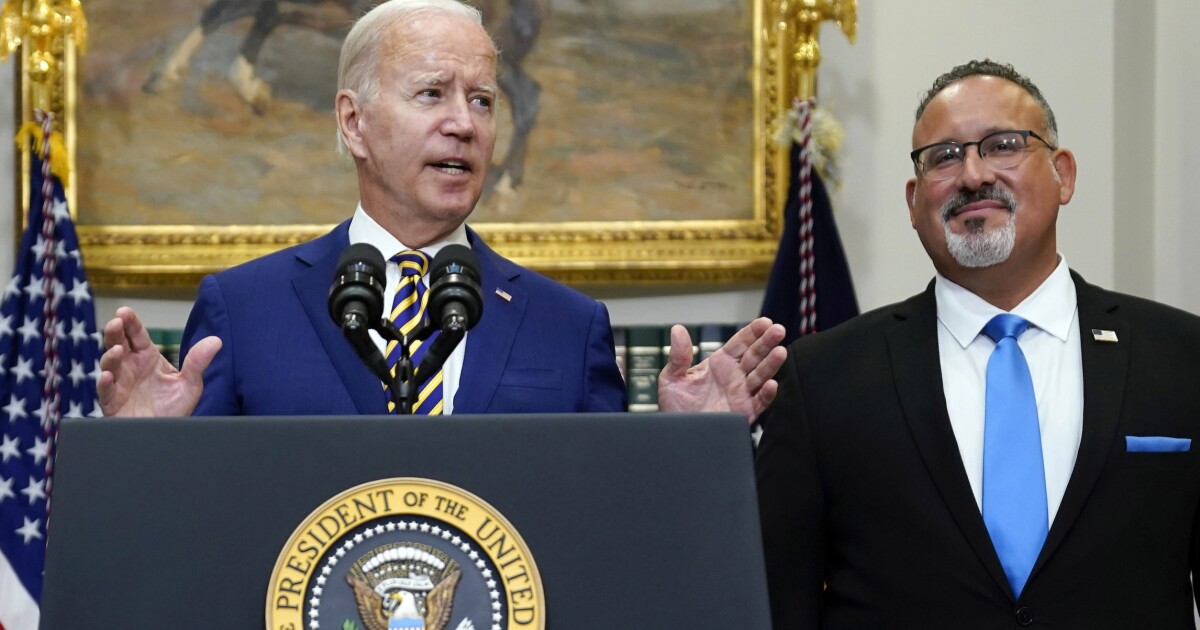

President Joe Biden made a big splash with his announcement of a $500 billion-plus student debt transfer.
In the weeks since the Aug. 24 move, the president has done his best not to disturb the political waters ahead of the midterm elections, barely mentioning the loan debt forgiveness plan.
Fulfilling a campaign promise and bowing to pressure from his party’s left wing, Biden announced late last month that he would transfer $10,000 of student debt from borrowers to taxpayers for all but the highest income earners and would shift up to $20,000 per borrower for those who received Pell Grants.
But Biden has barely mentioned the program since. The last time he spoke about it in a speech was Aug. 25, just a day after the news broke, during a Democratic National Committee rally in highly educated Montgomery County, Maryland. He last spoke about student loans in any form on Sept. 6, mentioning the debt transfer along with a host of other programs as “proof that democracy can deliver for the people.”
The president did not mention student loans during multiple campaign stops in Pennsylvania, a pair of speeches in Boston, a groundbreaking ceremony in Ohio, or in remarks at the Detroit Auto Show.
The silence comes as Democrats have gained traction in polls ahead of the midterm elections, when control of the House and Senate are at stake, along with 36 governorships and a slew of down-ballot offices.
Biden’s disappearing debt pledge largely amounts to smart politics, argued former Pennsylvania Democratic Party Chairman T.J. Rooney.
“It’s absolutely an issue that cuts both ways,” he said. “In every presidency, there comes a time where you have to follow through on a promise that you’ve made that isn’t necessarily politically expedient. This would certainly rise to that level.”
Biden pledged during the 2020 campaign to “cancel” $10,000 of student debt per borrower, though he spent his first 18 months in office saying Congress needed to act first before finally following through.
The blowback, at least theoretically, comes from all sides.
Some 43 million hold a collective $1.7 trillion in student debt, but that still only represents 13% of the overall population. And from the Left, figures such as Sen. Elizabeth Warren (D-MA) and groups such as the NAACP have called for a much larger figure of $50,000 per borrower, with the NAACP calling $10,000 an inequitable “slap in the face.”
Talking up the program could backfire with both.
“For as many people who benefit, there are 10 times as many who may feel aggrieved,” Rooney said.
That’s not to say the program itself is in danger. Education Secretary Miguel Cardona released details in early September, saying applications will open in early October, with borrowers seeing “relief” in as little as four weeks.
Applicants who file before Nov. 15 will be guaranteed to have balances lowered before the loans repayment pause ends at the end of the year, and some who made payments during the pause will even have their money refunded.
The idea may be that those who stand to benefit will need no reminders, while those who don’t will shift their attention elsewhere.
But even if Biden doesn’t talk about student loans this fall, the GOP will. Its leaders predict a blue-collar backlash from the two-thirds of voters who never attended college and from those who paid off their loans.
“What does it say for all those folks? ‘Boy, you were really stupid here,'” former Education Secretary Betsy DeVos told the Washington Examiner in June.
More than 20 GOP governors have urged Biden to ditch his plan, arguing in a joint letter that it benefits only an elite few and will cost taxpayers $2,000 per person.
Republicans are also trying to make Biden’s silence a talking point in and of itself.
“Joe Biden bailed out wealthy college grads yet is shy to mention it,” Republican National Committee spokesman Will O’Grady said. “Could it be because his bailout is extremely unpopular and out of touch?”
Any debts lifted from borrowers are not truly canceled but are absorbed by taxpayers and lumped into the national debt. The Committee for a Responsible Federal Budget estimates the program will cost $500 billion and will fuel inflation since money that would have gone to repaying debt will instead be spent on goods and services.
Despite the headwinds, there is some polling to back up the Democratic position.
Nearly half of respondents in a poll from left-wing think tank Data for Progress said broad student loan forgiveness would motivate them to vote, and Biden’s approval ratings have increased slightly since the program was announced.
Yet voters with strong opinions on the issue may still not be fired up enough to switch parties. And down-ballot Democrats worried about skeptics could point to the fact that Biden made the move without Congress, or just remain silent themselves.
“Biden owns it, so that makes it more of a luxury,” said Rooney, the Pennsylvania Democratic strategist. “It’s not a vote you have to defend because this is the president’s doing. You can bask in his reflected glory or, in most cases, you’ll run away from it like a house on fire.”




